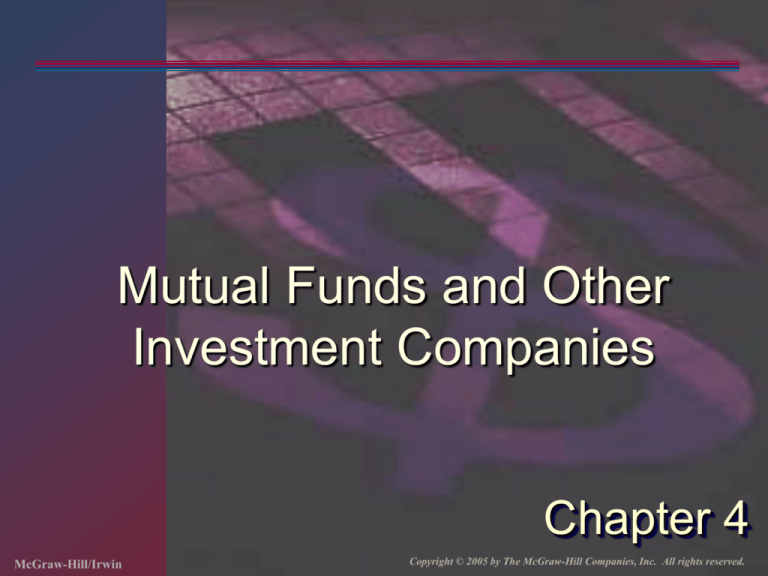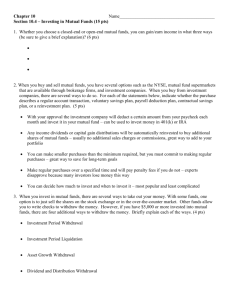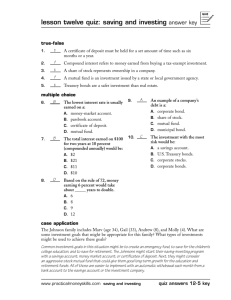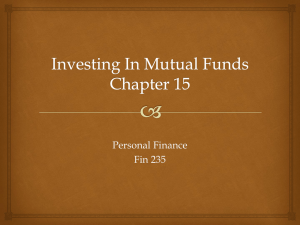
Mutual Funds and Other
Investment Companies
Chapter 4
McGraw-Hill/Irwin
Copyright © 2005 by The McGraw-Hill Companies, Inc. All rights reserved.
Investment Companies
Investment Company Act of 1940 which
classifies into:
Unit trusts – portfolio fixed for life of fund
(unmanaged)
Managed Investment Companies
Closed End
Open End – “Mutual Funds” About 90% of
investment company assets are here.
4-2
Other Investment Organizations
Commingled Funds – partnerships that pool
funds (e.g. trust or retirement accounts pool into
a common fund). Are like large investor open
ended funds
REIT (Real Estate Investment Trusts) – similar to
closed end funds, but established by separate
legislation and must invest passively in real
estate
Hedge Funds – not registered and not subject to
SEC regulation. Used by “sophisticated”
investors and financial intermediaries. Often use
high leverage
4-3
Mutual Funds
• Our goal in this chapter is to understand the
different types of mutual funds, their risks,
and their returns.
• Around 1980, 5 million Americans owned
mutual funds.
• However, by 2001, 93 million Americans in 55
million households owned mutual funds.
• In 2001 investors added $505 billion in net
new funds to mutual funds.
• In 2001, mutual fund assets totaled $7 trillion.
• In 2002, mutual fund assets totaled 6.4
trillion.
4-4
Mutual Funds
Mutual funds are simply a means of combining
or pooling the funds of a large group of
investors.
The buy and sell decisions for the resulting
pool are then made by a fund manager, who
is compensated for the service provided.
Like commercial banks and life insurance
companies, mutual funds are a form of
financial intermediary.
4-5
Mutual Fund Operations: Organization and Creation
A mutual fund is simply a corporation. It is
owned by shareholders, who elect a board of
directors.
Most mutual funds are created by investment
advisory firms (say Fidelity Investments), or
brokerage firms with investment advisory
operations (say Merrill Lynch).
Investment advisory firms earn fees for
managing mutual funds.
4-6
Taxation of Investment Companies
A “regulated investment company” does not
have to pay taxes on its investment income.
To qualify, an investment company must:
Hold almost all its assets as investments in
stocks, bonds, and other securities,
Use no more than 5% of its assets when
acquiring a particular security, and
Pass through all realized investment income to
fund shareholders
4-7
The Fund Prospectus and Annual Report
Mutual funds are required by law to
supply a prospectus to any investor who
wishes to purchase shares.
Mutual funds must also provide an
annual report to their shareholders.
4-8
Services of Investment Companies
Administration & record keeping
Diversification & divisibility
Professional management
Reduced transaction costs (economies
of scale in trading)
4-9
Investment Companies and Fund Types
An Investment company is business that
specializes in pooling funds from individual
investors and making investments.
An Open-end fund is an investment
company that stands ready to buy and sell
shares in itself to investors, at any time.
A Closed-end fund is an investment
company with a fixed number of shares that
are bought and sold by investors, only in the
open market.
4-10
Open-End and ClosedEnd Funds: Key Differences
Shares Outstanding
Closed-end: no change unless new stock is
offered.
Open-end: changes when new shares are
sold or old shares are redeemed.
Pricing
Open-end: Net Asset Value(NAV)
Closed-end: Premium or discount to NAV
4-11
Net Asset Value
Used as a basis for valuation of
investment company shares.
Selling new shares
Redeeming existing shares
Calculation
Market Value of Assets - Liabilities
Shares Outstanding
4-12
Mutual Fund Costs and Fees
Sales charges or “loads”
Front-end loads are charges levied on purchases.
Back-end loads are charges levied on redemptions.
12b-1 fees. SEC Rule 12b-1 allows funds to spend up to
1% of fund assets annually to cover distribution and
marketing costs.
Management fees:
Usually range from 0.25% to 1.00% of the funds total assets
each year.
Are usually based on fund size and/or performance.
4-13
Mutual Fund Costs and Fees
Trading costs
Not reported directly
Funds must report "turnover," which is related to
the amount of trading. ((Avg Assets)/Sales)
The higher the turnover, the more trading has
occurred in the fund which increases costs.
Turnover also creates capital gains for investors
Mutual Funds may be “reimbursed” for order flow
(increases trading costs, but is not a fee that is
reported). So called “soft dollars”
Benefit – a large trader like a mutual fund can get
good allocation of IPO’s
4-14
Expense Reporting
Mutual funds are required to report
expenses in a fairly standardized way in
their prospectus.
Shareholder transaction expenses - loads
and deferred sales charges.
Fund operating expenses - management
and 12b-1 fees, legal, accounting, and
reporting costs, director fees.
Must provide hypothetical example
showing the total expenses paid by
investors through time per $10,000
invested.
4-15
Example: Fee Table
4-16
Example: Fee Table
4-17
Why Pay Loads and Fees?
After all, many good no-load funds exist.
Don’t know any better? Or,
You may want a fund run by a particular
manager. All such funds are load funds.
Or, you may want a specialized type of fund.
Perhaps one that specialized in Italian
companies
Loads and fees for specialized funds tend to
be higher, because there is little competition
among them.
4-18
Investment Companies and Fund Types
4-19
Short-Term Funds, I.
Short-term funds are collectively known
as money market mutual funds.
They hold money market instruments
Money market mutual funds
(MMMFs) are mutual funds specializing
in money market instruments.
MMMFs maintain a $1.00 net asset value
to make them resemble bank accounts.
Depending on the type of securities
purchased, MMMFs can be either taxable
or tax-exempt.
Often allow “check writing”
4-20
Short-Term Funds, II.
Most banks offer what are called
“money market” deposit accounts, or
MMDAs, which are much like MMMFs.
The distinction is that a bank money
market account is a bank deposit and
offers FDIC protection.
4-21
Long-Term Funds
There are many different types of longterm funds, i.e., funds that invest in longterm securities.
Historically, mutual funds were classified
as stock funds, bond funds, or income
funds.
Nowadays, the investment objective of the
fund is the major determinant of the fund
type.
4-22
Stock Funds, I.
Some stock funds trade off capital appreciation
and dividend income.
Capital appreciation
Growth
Growth and Income
Equity income
Some stock funds focus on companies in a
particular size range.
Small company
Mid-cap
Some stock fund invest internationally.
Global
International
Region
Country
Emerging markets
4-23
Stock Funds, II.
Sector funds specialize in specific sectors of the
economy, such as:
Biotechnology
Internet
Energy
Other fund types include:
Index funds
Social conscience, or “green,” funds
“Sin” funds (i.e., tobacco, liquor, gaming)
Tax-managed funds
4-24
Index Funds
Pioneered by Vanguard. Its “Index Trust
500”, based on the S&P 500 is the largest
mutual fund in the world (Inception:
August 31, 1976)
Very low costs – typically 20 bp or less for
S&P 500 based funds. Higher for
specialty indexes and international
Low turnover (5% annually, versus 85%
for the average managed stock fund)
Tax efficient – it is typically near the top
20% of funds on an after tax basis
4-25
From Vanguard.com
Statistical snapshots
71% of Vanguard index funds outperformed
their respective peer-group averages over the
ten years ended March 31, 2006.
When Vanguard 500 Index Fund began
operations in 1976, it was one of 360 U.S.
stock funds; 149 of these no longer exist.
2005 expense ratios for funds tracking the
S&P 500 Index: Industry average: 0.59%;
Vanguard 500 Index Fund: 0.09% (Admiral™
Shares) and 0.18% (Investor Shares).Source
of industry data: Lipper Inc.
4-26
Bond Funds
Bond funds may be distinguished by their
Maturity range
Credit quality
Taxability
Bond type
Issuing country
Bond fund types include:
Short-term and intermediate-term funds
General funds
High-yield funds
Mortgage funds
World funds
Insured funds
Single-state municipal funds
4-27
Stock and Bond Funds
Funds that do not invest exclusively in either
stocks or bonds are often called “blended” or
“hybrid” funds.
Examples include:
Balanced funds
Asset allocation funds
Convertible funds
Income funds
4-28
Mutual Fund Objectives:
A mutual fund “style” box is a way of
visually representing a fund’s
investment focus by placing the fund
into one of nine boxes:
Value
Style
Blend
Growth
Size
Large
Medium
Small
4-29
Mutual Fund Objectives:
In recent years, there has been a trend
toward classifying a mutual fund’s objective
based on its actual holdings.
For example, the Wall Street Journal
classifies most general purpose funds based
on the market “cap” of the stocks they hold,
and also on whether the fund tends to invest
in “growth” or “value” stocks (or both).
4-30
Mutual Fund Objectives
4-31
Mutual Fund Performance
Mutual fund performance is very closely
tracked by a number of organizations.
Financial publications of all types
periodically provide mutual fund data.
The Wall Street Journal is particularly
timely print source.
www.morningstar.com has a “Fund
Selector” that provides performance
information
4-32
Mutual Fund Performance
4-33
Mutual Fund Performance
4-34
A First Look at Fund Performance
Benchmark: Wilshire 5000
Results
Most funds underperform
Not fair comparison because of costs
Adjusted Benchmark: Wilshire 5000
with passive management costs
considered.
The majority of funds still under-perform.
4-35
Consistency of Fund Performance
Do some mutual funds consistently
outperform?
Evidence suggests that some funds
show consistent stronger performance.
Depends on measurement interval
Depends on time period
Evidence shows consistent poor
performance.
4-36
Mutual Fund Performance
While looking at historical returns, the
riskiness of the various fund categories
should also be considered.
Whether historical performance is useful
in predicting future performance is a
subject of ongoing debate.
Some of the poorest-performing funds are
those with very high costs.
4-37
Closed-End Fund Performance
A closed-end fund has a fixed number
of shares.
These shares are traded on stock
exchanges.
There are about 450 closed-end funds that
have their shares listed on U.S. Stock
Exchanges.
There are about 7,000 long-term open-end
mutual funds.
4-38
Mutual Fund Performance
4-39
The Closed-End Funds Discount
Most closed-end funds sell at a discount
relative to their net asset values.
The discount is sometimes substantial.
The typical discount fluctuates over time.
Despite a great deal of academic
research, the closed-end fund discount
phenomenon remains largely
unexplained.
4-40
Exchange Traded Funds
An exchange traded fund, or ETF,
Is basically an index fund.
Trades like a closed-end fund (without the discount
phenomenon). They are heavily traded.
An area where ETFs seem to have an edge
over the more traditional index funds is the
more specialized indexes.
A well-known ETF is the “Standard and Poor’s
Depositary Receipt” or SPDR.
This ETF mimics the S&P 500 index.
It is commonly called “spider."
A list of ETFs can be found at www.amex.com.
4-41
Hedge Funds
Like mutual funds, hedge funds collect pools of
money from investors. However,
Hedge funds are not required to register with the SEC.
Hedge funds are not required to maintain any particular degree
of diversification or liquidity. Are often highly levered.
Hedge fund investors must qualify as “financially sophisticated”
investors.
Hedge fund managers have considerable
freedom to follow various investment strategies,
or styles.
Hedge fund fees:
General management fee of 1-2% of fund assets
Performance fee of 20-40% of profits
4-42
Useful Internet Sites
www.ici.org (reference for mutual fund facts and figures)
www.vanguard.com (example of major fund family website)
www.fidelity.com (website of largest investment advisory firm in
US)
www.ipsfunds.com (reference for “plain language” risk disclosure)
www.mfea.com (reference for info on thousands of funds)
www.morningstar.org (reference for one of the best mutual fund
sites)
www.vicefund.com (reference for “vice” funds)
www.socialinvest.org (reference for “social conscience” funds)
www.hedgefundworld.com (reference for hedge fund information)
www.turnkeyhedgefunds.com (reference to start your own hedge
fund)
4-43
Review: Mutual Funds
Investment Companies and Fund Types
Open-End versus Closed-End Funds
Net Asset Value
Mutual Fund Operations
Mutual Fund Organization and Creation
Taxation of Investment Companies
The Fund Prospectus and Annual Report
Mutual Fund Costs and Fees
Types of Expenses and Fees
Expense Reporting
Why Pay Loads and Fees?
Short-Term Funds
Money Market Mutual Funds
Money Market Deposit Accounts
4-44
Review: Mutual Funds
Long-Term Funds
Stock Funds
Taxable and Municipal Bond Funds
Stock and Bond Funds
Mutual Fund Objectives: Recent Developments
Mutual Fund Performance
Mutual Fund Performance Information
How Useful are Fund Performance Ratings?
Closed-End Funds and Exchange Traded Funds
Closed-End Funds Performance Information
The Closed-End Fund Discount Mystery
Exchange Traded Funds
4-45








